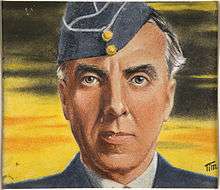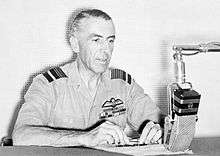Richard Peirse
- This article is about the World War II air chief marshal. For his son, who reached the rank of air vice marshal, see Richard Peirse (RAF officer). For his father, a Royal Navy admiral, see Richard Peirse (Royal Navy officer)
| Sir Richard Edmund Charles Peirse KCB, DSO, AFC | |
|---|---|
 Portrait of Peirse commissioned by the Ministry of Information circa 1943 | |
| Born |
30 September 1892 Croydon, England |
| Died | 5 August 1970 (aged 77) |
| Allegiance |
|
| Service/branch |
|
| Years of service | 1912–1945 |
| Rank | Air Chief Marshal |
| Commands held |
|
| Battles/wars | |
| Awards | |
| Relations |
|
Air Chief Marshal Sir Richard Edmund Charles Peirse, KCB, DSO, AFC (30 September 1892 – 5 August 1970) was a senior Royal Air Force commander.
RAF career
Born the son of Admiral Sir Richard Peirse and educated at Monkton Combe School and at King's College London, Peirse became a midshipman in the Royal Navy Volunteer Reserve and was commissioned in 1912.[1] He was awarded the Distinguished Service Order for his contribution to the aerial attack on Dunkirk on 23 January 1915.[1] and was promoted to flight commander in May 1915.[2] He was further promoted in July 1916 to squadron commander.[3]
Later that year, on 18 August 1915, Peirse married Mary Joyce Ledgard (1894–1975), younger daughter of Mr and Mrs Armitage Ledgard, of the Manor House, Thorner, Yorkshire. They had one son and one daughter. The marriage was dissolved in 1945.
Peirse served as a pilot with the Royal Naval Air Service until 1 April 1918 when it became part of the Royal Air Force.[1] With the formation of the RAF, Peirse became Officer Commanding No. 222 Squadron.[1] Following promotion to wing commander in January 1922,[4] in 1923 he became Station Commander at RAF Gosport and in 1929 he was made Station Commander at RAF Heliopolis.[1] He was also promoted to group captain in 1929.[5] He went on to be Deputy Director of Operations and Intelligence at the Air Ministry in 1930 and, having been promoted to Air Commodore in 1933,[6] was appointed Air Officer Commanding Palestine Transjordan Command.[1] Promoted again, this time to Air Vice-Marshal in 1936, he was appointed Deputy Chief of the Air Staff and Director of Operations and Intelligence in January 1937.[1][7]

In the Second World War, as a temporary air marshal, he became Vice-Chief of the Air Staff from April 1940[8] and having had his rank confirmed as permanent in July,[9] he became Air Officer Commanding-in-Chief Bomber Command from October 1940.[1] He presided over a large expansion in the bomber force (and appeared in the propaganda film Target for Tonight), but was removed in January 1942 by the Chief of the Air Staff, Air Chief Marshal Charles Portal, when he became increasingly concerned about the mounting losses.[10] In March 1943 Peirse was appointed Air Officer Commanding-in-Chief RAF India and in November 1943 he was made Allied Air Commander in Chief, South-East Asia.[1] He oversaw the building of his command from a small demoralised and poorly organised force with a collection of obsolescent aircraft into a powerful force with a three to one numerical superiority over the enemy.[11] Although seen as somewhat aloof, he fought fiercely to bring the structure and resources needed for his command and was seen to make an able contribution to the higher direction of the war in the South East Asian theatre.[12]
After a six-month extension,[12] his term of office expired in November 1944 and was not renewed.[13] He retired in May 1945 with the rank of air chief marshal[14] but never received advancement to the Grand Cross level in the orders of knighthood which would normally have been forthcoming to an officer of his rank at the time. The reason for the abrupt termination of his career lay in his affair with Lady (Jessie) Auchinleck, the wife of his friend, Field Marshal Sir Claude Auchinleck, then Commander in Chief India.
The affair became known to Mountbatten in early 1944, and he passed the information to the Chief of the RAF, Sir Charles Portal, hoping that Peirse would be recalled. The affair was common knowledge by September 1944, and Peirse was considered to be neglecting his duties. Mountbatten sent Peirse and Lady Auchinleck back to England on 28 November 1944,[12] where they lived together at a Brighton hotel. Peirse had his marriage dissolved in 1945, and the Auchinlecks divorced in December 1945. Peirse and the former Lady Auchinleck married the following year.
Awards and decorations
 Distinguished Service Order – 10 April 1915[15]
Distinguished Service Order – 10 April 1915[15] Air Force Cross[16] – 1 January 1919.
Air Force Cross[16] – 1 January 1919. Croce di Guerra by the King of Italy for services rendered in the Mediterranean area – 1 April 1919[17]
Croce di Guerra by the King of Italy for services rendered in the Mediterranean area – 1 April 1919[17].svg.png) Companion of the Order of the Bath – 6 November 1936[15]
Companion of the Order of the Bath – 6 November 1936[15].svg.png) Knight Commander of the Order of the Bath – 11 July 1940[15]
Knight Commander of the Order of the Bath – 11 July 1940[15] Order of Polonia Restituta, 2nd Class[15] (Poland) – 29 May 1942
Order of Polonia Restituta, 2nd Class[15] (Poland) – 29 May 1942 Grand Cross of the Order of Orange-Nassau[15] (Netherlands) – 12 Jan 1943.
Grand Cross of the Order of Orange-Nassau[15] (Netherlands) – 12 Jan 1943. Commander of the Legion of Merit (USA)[15] – 15 March 1946
Commander of the Legion of Merit (USA)[15] – 15 March 1946 Cloud and Banner Decoration (Third Grade) (China)[15] – 29 July 1947
Cloud and Banner Decoration (Third Grade) (China)[15] – 29 July 1947 Mentioned in Despatches (3) – 17 February 1915, 3 June 1918[18] and 3 December 1942.
Mentioned in Despatches (3) – 17 February 1915, 3 June 1918[18] and 3 December 1942.
Notes
- 1 2 3 4 5 6 7 8 9 Air of Authority – A History of RAF Organisation – Air Chief Marshal Sir Richard Peirse
- ↑ The London Gazette: no. 29162. p. 4651. 14 May 1915. Retrieved 13 November 2012.
- ↑ The London Gazette: no. 29687. p. 7481. 28 July 1916. Retrieved 13 November 2012.
- ↑ The London Gazette: (Supplement) no. 32563. p. 10719. 30 December 1921. Retrieved 13 November 2012.
- ↑ The London Gazette: no. 33513. p. 4365. 2 July 1929. Retrieved 13 November 2012.
- ↑ The London Gazette: no. 33955. p. 4386. 30 June 1933. Retrieved 13 November 2012.
- ↑ The London Gazette: no. 34363. p. 560. 26 January 1937. Retrieved 13 November 2012.
- ↑ The London Gazette: no. 34840. p. 2556. 30 April 1940. Retrieved 13 November 2012.
- ↑ The London Gazette: no. 35525. p. 1648. 14 April 1942. Retrieved 13 November 2012.
- ↑ Royal Air Force Bomber Command 60th Anniversary
- ↑ Bond & Tachikawa 2004, pp. 124–126.
- 1 2 3 Bond & Tachikawa 2004, p. 124.
- ↑ Woodburn Kirby 2004, p. 118.
- ↑ The London Gazette: (Supplement) no. 37393. p. 6149. 14 December 1945. Retrieved 13 November 1945.
- 1 2 3 4 5 6 7 L, Klemen (1999–2000). "Air Chief Marshal Sir Richard Edmund Charles Peirse". Forgotten Campaign: The Dutch East Indies Campaign 1941–1942.
- ↑ The London Gazette: (Supplement) no. 31098. p. 97. 31 December 1918. Retrieved 13 November 2012.
- ↑ The London Gazette: (Supplement) no. 31273. p. 4513. 4 April 1919. Retrieved 13 November 2012.
- ↑ The London Gazette: (Supplement) no. 30722. p. 6522. 31 May 1918. Retrieved 13 November 2012.
References
- Bond, Brian; Tachikawa, Kyoichi, eds. (2004). British and Japanese Military Leadership in the Far Eastern War, 1941–1945. London/New York: Frank Cass. ISBN 9780714656595.
- Woodburn Kirby, Major-General S. (2004) [1st. pub. HMSO:1965]. Butler, Sir James, ed. The War Against Japan, Volume IV: The Reconquest of Burma. History of the Second World War, United Kingdom Military Series. Uckfield, England, UK: Naval & Military Press. ISBN 1-845740-63-7.
External links
 Media related to Richard Peirse at Wikimedia Commons
Media related to Richard Peirse at Wikimedia Commons
| Military offices | ||
|---|---|---|
| Preceded by Christopher Courtney |
Deputy Chief of the Air Staff and Director of Operations and Intelligence 25 January 1937 – 22 April 1940 |
Succeeded by Sholto Douglas |
| New title Post created |
Vice-Chief of the Air Staff 22 April 1940 – 4 October 1940 |
Succeeded by Sir Wilfrid Freeman |
| Preceded by Sir Charles Portal |
Commander-in-Chief Bomber Command 1940–1942 |
Succeeded by Jack Baldwin |
| Preceded by Sir Patrick Playfair |
Commander-in-Chief, Air Forces in India 1942–1943 |
Succeeded by Sir Guy Garrod |
| New title Command established |
Commander-in-Chief Air Command South-East Asia 16 November 1943 – 27 November 1944 |
Succeeded by Sir Guy Garrod Temporary appointment |
